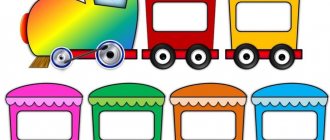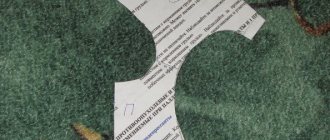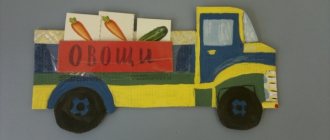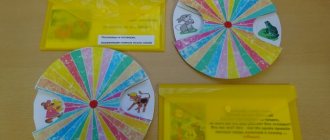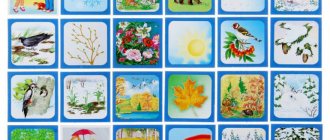DIY games for children 2-3 years old
DIY games for young children
Author Emelyanova Sirina Raisovna Place of work teacher MBDOU No. 10 “Constellation” ZMR RT Republic of Tatarstan Zelenodolsk Goals : to develop games suitable for young children - safe and easily accessible ******* I work with children of an early age and, from work experience, I can say that early childhood is the basis for the overall development of a child, the starting period for all human endeavors. Children's attention is still involuntary. Thinking is visual and effective, and play is the leading activity through which cognitive activity is formed, expressed in constant research and knowledge of surrounding objects. PLAY is a need for a growing child's body. The game develops cognitive mental processes: perception, memory, thinking, attention, imagination, speech; curiosity and mental abilities develop; primary intellectual skills. Children of this age actively explore the world according to the principle: “What I see, what I act with, that is what I learn.” Children develop simple forms of visually effective thinking, the most primary generalizations, directly related to the identification of certain external and internal characteristics of objects. It is by playing with a child that you can develop all the necessary skills, abilities and knowledge. The following are homemade games for young children that include a variety of tasks. 1 game. “Flower Meadow” (made of satin ribbons with Velcro) Goals of the game: • Development of sensory perception; • Development of perseverance; • Enrichment of tactile sensitivity; Fixing color and size; • Development of creative abilities. Flowers can also be used on a Velcro sensory mat.
Game 2 “Guess what kind of fruit.” (Fruits are cut out from transparent folders and are visible on colored paper) Goals of the game: • Develop the ability to distinguish and name colors; • Develop the ability to distinguish and name fruits and vegetables; • Develop thinking, memory, imagination and logic; • Activate speech.
Game 3 "Fruit - stencils." (White sheets of paper are placed in transparent folders, and when painted over, a fruit appears on the sheet. Stencils can be cut out on any theme and can be reused after washing with water). Objectives of the game: • Develop fine motor skills of the hands • Develop the ability to hold a brush correctly • Form children’s idea of the outline of the drawing • Reinforce primary colors • Develop speech, attentiveness and accuracy
Game 4 Lotto “Big-Small” Pictures are pasted onto pasted juice boxes. Children match the Large image to the small one. This lotto can also be used as building blocks. Goals of the game: • Fix colors • Form an idea of size (large cube - small) • Develop the ability to correlate objects by size (big bunny - small) • Develop memory, logical thinking, imagination • Develop construction skills • Develop perseverance and attentiveness • Activate speech
Game 5 Children's bowling Also, pasted over elongated juice boxes can be used as pins for children's bowling. Goals of the game: • Develop coordination of movements • Develop hand-eye coordination, eye • Develop accuracy, determination, attentiveness • Develop hand motor skills • Develop spatial orientation
Game 5 “Inserts” (from viscose napkins) Inserts can be cut out on any theme: clothing, food, geometric shapes, etc. The child learns to select figures according to shape and insert them into the corresponding holes. Goals of the game: • Develop motor skills of the fingers through actions with objects • Develop tactile sensations • Develop a holistic perception of an object • Promote the development of the ability to correlate objects by shape and color • Develop logical thinking and attentiveness • Expand children’s passive vocabulary and activate speech
Game 6 "Long short". The game is presented in two versions. First option. A box with only 2 ribbons: long and short. Second option. A box with different ribbons: different in length, color, width, which promotes children's research activities. Goals of the game: • To reinforce with children the concepts of long - short, narrow - wide. • Develop the ability to distinguish and name colors • Develop motor skills of fingers through actions with objects • Develop tactile sensations • Develop memory, thinking and logic
Game 7 "Magic Box" In a large glued box, holes for building material are cut out to suit the shape. Goals of the game: • To consolidate children’s knowledge about geometric shapes • To develop holistic perception, thinking, spatial orientation • To learn to relate figures • To develop fine motor skills of hands • To develop perseverance
Game 8 Tube for balls (made of cardboard). Goals of the game: • Conducting experimental and research activities • Consolidating sizes - large and small • Developing attention and thinking
We recommend watching:
Didactic games for children of the first junior group Educational game “Shape, color, size” for children 2-3 years old Adaptation games in kindergarten Game with logic blocks for children of primary preschool age
Similar articles:
Educational games for children 2-3 years old in kindergarten. Card index
Outdoor games for young children in kindergarten
Didactic game for children 2-3 years old “Let’s feed the doll lunch”
Didactic game for children 2-3 years old “Dolls visiting children”
Didactic games on social development in the younger group of kindergarten
▣ SUBSCRIBE ON INSTAGRAM➥
2018-02-09 11:04:40 0 7176
Educational toys, invented by the talented Italian teacher Maria Montessori more than a hundred years ago, are very, very popular among modern parents and children. Which is quite natural: these educational toys are bright, simple and at the same time interesting and useful for both the youngest and older children!
Insert frames are very diverse. They differ from each other in shape, theme, age purpose, technical design (for example, wooden frames-inlays). Whatever the toy, the main thing is that it brings great benefits to the baby. The main task of the game is to return the cut out small part to its place, after first matching the shape and size of the element and the “house” for it. In some toys, it is possible to navigate by the meaning of the picture, while in others, shape and size are the only defining characteristics. Interesting, isn't it?
For example, simple frame inserts can be offered to babies from 6 to 8 months, and more serious options will captivate children up to 5 to 6 years old!
The toy is a tablet-like tablet with parts of different shapes cut out in it. They can be taken out of the frame and put back in place. Most often, the parts are equipped with a button-handle, which makes them very convenient to grasp. But there is a secret in the purpose of this button: it is not only for convenience! The fact is that the baby grasps the button with three fingers: thumb, index, middle - that is, those with which he will later hold a pencil and pen!
Did you guess it? The main benefits of frame inserts:
- fine motor skills training;
- Preparing the baby's hand for writing.
But that's not all! Frame inserts:
- They develop logic and coordination of the tiny baby’s movements (it’s not so easy to get a piece into a frame, and you also have to figure out how to turn it correctly so that it fits into place!).
- They teach you to distinguish geometric shapes, sizes, colors, and help you learn to count.
- With the help of insert frames, you can clearly explain to your child the concept of “whole” and “fraction”. There is an option where you need to insert a whole circle into the frame, next to it is a circle consisting of two halves, then three, four, and so on! There are a total of 72 elements in this constructor! Of course, this model is not suitable for the tiniest.
- Thematic frame inserts introduce the baby to the world of animals, technology, vegetables and fruits, even geography! While playing, the baby will easily remember, for example, that banana, pear and apple can be called the general word “fruit”.
- the baby becomes more inquisitive and expands his vocabulary.
This is what a powerful developmental potential lies in a simple-looking toy!
And now we need to find out what types of frames and inserts there are in order to choose the right option for the baby in accordance with his tastes and age.
INSERT FRAMES ARE MORE OR LESS.
In one frame there are four identical in appearance, but different in size bunnies, dogs or other animals. The task is to put the pieces in their places. This version of the insert frame can be given to a baby as early as six months, but, of course, you shouldn’t expect the baby to immediately arrange everything on his own! The baby will be able to do everything himself later, when he’s a year and a half old, but for now, moms and dads, play with him!
THEMED FRAME INSERTS.
Frames with inserts in the form of figurines, animals, gifts of nature, cars will be of interest to daughters and sons from 1.5 to 2 years old. The option of a frame with an underlayer simplifies the task for children - a similar pattern is applied in the slots of the frame to facilitate the selection of parts.
For two to three year old children, more complex options are suitable - geometric shapes divided into parts by straight or wavy lines; with numbers and letters that need to be placed in the corresponding silhouettes.
DRESSING FRAMES.
Children really like to match blouses and pants to the figures of children or animals, as well as different faces: funny, angry, surprised! By playing with “dress up”, you can learn very, very many important, interesting things. For example, learning the names of items of clothing, getting to know the seasons, and faces will help the baby recognize various emotions. The game will be much more exciting with mom’s comments: “The bear is going for a winter walk. What should I take – maybe some pajamas?” Of course, the baby will choose a fur suit with a satisfied smile! You can write whole stories on the topic of how the bear got up, took off his pajamas, put on something appropriate for the season, went for a walk, got scared, for example, of a caterpillar, and then realized that there was nothing to be afraid of and laughed... Use your imagination and play with the insert frame will take on new dimensions!
GEOGRAPHICAL INSERT MAPS
– the most interesting Montessori idea! This frame is intended for older children, but will be interesting even for adults. It's really fun to arrange the continents in their places on the hemispheres! A great way to learn geography. By the way, it was prefabricated geographical maps for children, which appeared at the end of the 18th century, that are the “great-grandfathers” of modern puzzles! Interested?
We will be very glad if you and your children enjoy these games.
We wish you exciting games and great success!

